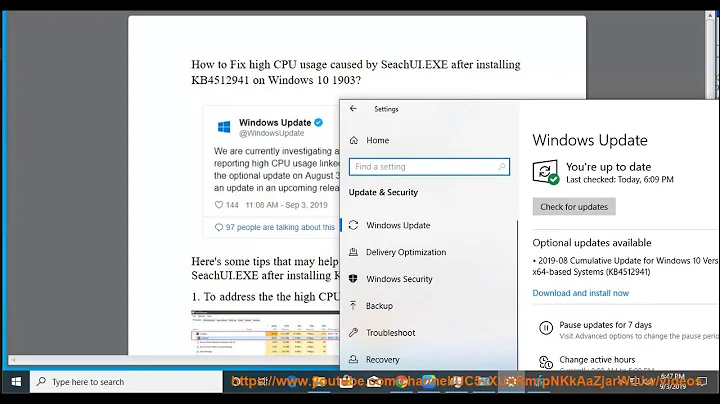KVM: High host CPU load after upgrading VM to windows 10 1803
Solution 1
Found someone with the same issue and a possible fix for it here: https://forum.proxmox.com/threads/high-cpu-load-for-windows-10-guests-when-idle.44531/
Tested changing my own config, and setting hpet to yes in the vm xml fixed it for me.
<clock offset='localtime'>
<timer name='rtc' tickpolicy='catchup'/>
<timer name='pit' tickpolicy='delay'/>
<timer name='hpet' present='yes'/>
<timer name='hypervclock' present='yes'/>
</clock>
hpet part is important.
Solution 2
Got the same issue with Windows 10 21H1 and qemu-kvm-4.2.0.
When windows machine was idle, I got around 30% cpu usage.
After the fix, I get about 5%.
Got the issue resolved by adding hv_synic & hv_stimer hyperv enlightments.
You might get stuck with the following error
error: Failed to start domain mymachine.local
error: internal error: process exited while connecting to monitor: Hyper-V synthetic timers (hv-stimer) requires Hyper-V clocksources (hv-time)
Hyper-V synthetic interrupt controller (hv-synic) requires Hyper-V VP_INDEX MSR (hv-vpindex)
2021-09-22T20:30:06.440656Z qemu-kvm: kvm_init_vcpu failed: Function not implemented
In order to get the above enlightments to work, you have to add hv_time (which is translated to hypervclock in libvirt) and hv_vpindex enlightments too.
My final libvirt XML file looks like
<features>
<acpi/>
<apic/>
<hyperv>
<relaxed state='on'/>
<vapic state='on'/>
<spinlocks state='on' retries='8191'/>
<vpindex state='on'/>
<synic state='on'/>
<stimer state='on'/>
</hyperv>
<smm state='on'/>
</features>
<clock offset='localtime'>
<timer name='rtc' tickpolicy='catchup'/>
<timer name='pit' tickpolicy='discard'/>
<timer name='hpet' present='yes'/>
<timer name='hypervclock' present='yes'/>
</clock>
Disclaimer: This has been done under CentOS 8, but should work under any libvirt controlled KVM.
Related videos on Youtube
giox069
Updated on September 18, 2022Comments
-
 giox069 over 1 year
giox069 over 1 yearI'm running an Ubuntu 16.04 server with KVM/libvirt/qemu and Windows 10 virtual machine. After upgrading Windows 10 to the latest 1803 version (April 2018 Update), i noticed a slowdown in the VM responsiveness and a too high CPU load in the host. The tests I did:
- "top" used on the host reports that the qemu-system-x86 process is taking 38-44% of CPU, while the VM is idle and reporting 4-6% of load inside windows process manager. When windows shows 50% of CPU load, the host shows 150-200% cpu load for the qemu-system-x86 process. This 8-10x increase in host CPU load does not occur with the old windows 10 1709 VM.
- "dstat" on the host reports a lot of system->csw, about 13k.
- I tested another system with the same setup with an AMD FX-4300, Ubuntu 17.10 dekstop + kvm, upgraded windows 10 to 1803 and I have the same problem of high host CPU and dstat-csw also on this machine.
- I took a third machine with an intel core i7, installed a new Ubuntu 18.04 desktop + kvm, installed a fresh new Windows 10, installed Virtio drivers available from here and I have the same high cpu problem.
What can I do? Am I using the right virtio drivers?
Thank you
-
 giox069 almost 6 yearsIt works! Host CPU load is reduced a lot. I have also found another post on reddit which suggested to remove the following parameters from qemu commandline:
giox069 almost 6 yearsIt works! Host CPU load is reduced a lot. I have also found another post on reddit which suggested to remove the following parameters from qemu commandline:-no-hpet-rtc base=localtime,driftfix=slew-global kvm-pit.lost_tick_policy=discardwhich translates into a slightly different .xml for libvirtd:<timer name='rtc' tickpolicy='delay'/><timer name='pit' tickpolicy='catchup'/><timer name='hpet' present='yes'/>Also with the above rtc/pit settings host cpu usage is reduced. VM general performances seems to be a bit lower than windows 1709. -
 giox069 over 5 yearsIt also seems that <timer name='pit' tickpolicy='discard'/> (instead of 'delay') improves general VM performances. Ubuntu 16.04 does not support it. I upgraded to 18.04.
giox069 over 5 yearsIt also seems that <timer name='pit' tickpolicy='discard'/> (instead of 'delay') improves general VM performances. Ubuntu 16.04 does not support it. I upgraded to 18.04. -
Costin Gușă over 5 yearsfor me enabling <synic state='on'> and <stimer state='on'> lowered the cpu usage to under 3%, with almost all cycles used by kernel kvm threads (looking at threads with top, qemu-kvm-ev uses zero cpu on rhel7.5 and kernel 4.16 from fedora28 for a q35 uefi win10 vm); source bugs.launchpad.net/qemu/+bug/1775702




